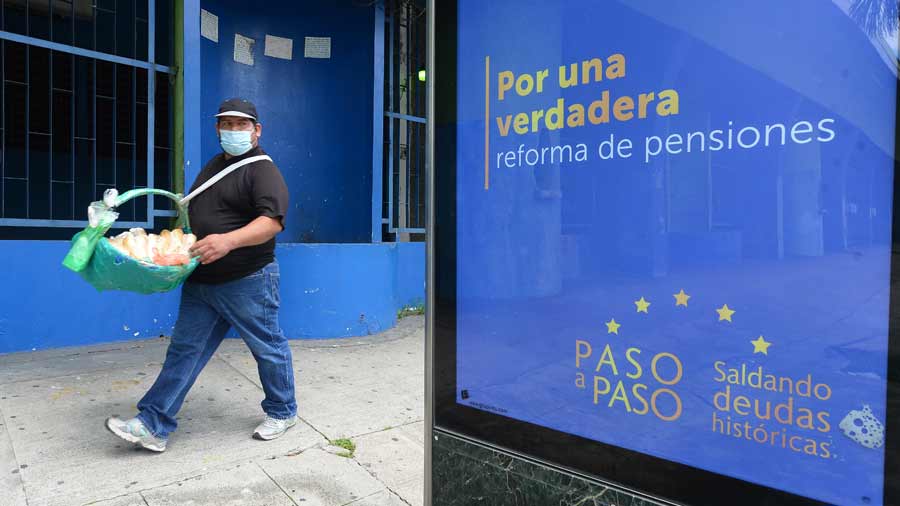The new pension debt, which began issuance in 2023 through Pension Obligation Certificates (COP), continues to accelerate in 2024.
According to the latest data from the Banco Central de Reserva (BCR) (Central Reserve Bank), last August, the government borrowed another $46 million from the fund saved by workers, bringing the total to $737.9 million in the first eight months of the year.
This figure exceeds by $177.8 million (31% more) what was borrowed from savings in 2023, when, over the same period from January to August, it borrowed $560.1 million.
The COPs are a new mechanism that the government included in the 2022 pension reform to tap into workers’ savings, which must later be returned to them with interest.
The Instituto Salvadoreño de Pensiones (ISP) (Salvadoran Pension Institute) issues the Certificates, and the AFP hands over the money from current contributors so it can pay the retirees of the ISSS and INPEP, in the public pension system that was abolished in 1998, but for which the government remains responsible for providing benefits.
According to the BCR, from January 2023 to August, a total of $1,835.65 million in COP has been issued. The largest issuance of COP occurred in April 2023, with an amount of $315 million between January and August. Subsequently, $249 million was issued in October.
This year, the largest issuances of COP were made between January and March and have started to decrease since April.
Before the COP existed, there was another financial mechanism called Pension Investment Certificates (CIP) through which the governments of Antonio Saca, Mauricio Funes, and Salvador Sánchez Cerén also borrowed money from AFP contributors.
This was repealed in 2022, and COP was created in its place, a mechanism that increasingly borrows more money than was taken when the CIP existed.
For Patricio Pineda, founder of the Mesa de Trabajo por una Pensión Digna (Working Group for Dignified Pensions), it is clear that the government is not only borrowing money to pay the pensions of today’s retirees but is also using the pension fund to finance other expenses, based on the report by the British financial firm Barclays from last March.
“It has never been seen a level of debt in the pension fund of these latitudes in less than two years. That money is being taken to self-finance and cover their needs.”
Deuda de pensiones en COP es 31% mayor que hace un año
La nueva deuda de pensiones, que comenzó a emitirse a partir de 2023 y que se obtiene a través de Certificados de Obligaciones Previsionales (COP), se sigue acelerando en 2024.
Según el nuevo dato del Banco Central de Reserva (BCR), en agosto pasado, el gobierno tomó prestados otros $46 millones más del fondo ahorrado por los trabajadores, con lo cual, acumula un saldo de $737.9 millones en ocho meses del año.
La cifra supera en $177.8 millones (un 31% más) a lo que tomó prestado de los ahorros en 2023, cuando en la misma fecha, entre enero y agosto, prestó $560.1 millones.
Los COP son una nueva figura que el gobierno incluyó en la reforma de pensiones de 2022 para tomar dinero de los ahorros de los trabajadores, a quienes luego debe regresárselos con intereses.
El Instituto Salvadoreño de Pensiones (ISP) emite los Certificados y las AFP le entrega el dinero de los cotizantes actuales para que pueda pagar a los jubilados del ISSS y el INPEP, en el sistema de pensiones público, que fue derogado en 1998, pero del que el Gobierno sigue siendo responsable de darles su beneficio.
Según el BCR, desde enero de 2023 hasta agosto, se han emitido un total de $1,835.65 millones en COP.
La mayor colocación de COP se dio en abril de 2023, con un monto de $315 millones entre enero y agosto. Posteriormente colocó $249 millones en octubre.
Este año, las mayores colocaciones de COP se hicieron entre enero y marzo y han comenzado a disminuir desde abril.
Antes de los COP, existía otra figura económica llamada Certificados de Inversión Previsional (CIP) con la que los gobiernos de Antonio Saca, Mauricio Funes y Salvador Sánchez Cerén, también tomaron prestado dinero de los cotizantes de las AFP.
Esta fue derogada en 2022 y en su lugar se crearon los COP, una figura que cada vez toma prestado más dinero del que se tomaba cuando existían los CIP.
Para Patricio Pineda, fundador de la Mesa de Trabajo por una Pensión Digna, está claro que el gobierno no solo está tomando dinero para pagar las pensiones de los jubilados de hoy, sino que también está usando el fondo de pensiones para financiar otros gastos, tomando como base el informe de la financiera inglesa Barclays, de marzo pasado.
“Jamás se había visto un nivel de endeudamiento del fondo previsional de estas latitudes en menos de dos años. Ese dinero que está sacando es para autofinanciarse y cubrir sus chillos”.

